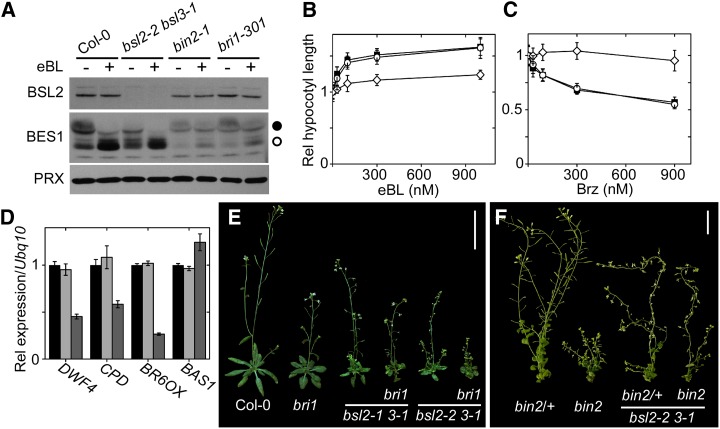Figure 5.
BR responses in bsl2 bsl3 mutants. A, Change in BES1 phosphorylation in response to treatment with eBL. Twelve-day-old seedlings of the indicated genotypes were treated with 1 μm eBL or with the equivalent amount of solvent for 2 h in the light. Western blots were processed as described in “Materials and Methods.” Black and white dots indicate fully phosphorylated and dephosphorylated BES1, respectively. PRX, Peroxiredoxin. B, Response to eBL in bsl2-2 bsl3-1 mutants. Four-day-old Col-0 (black squares), bsl2-2 bsl3-1 (white circles), and bri1-301 (white diamonds) seedlings were grown in dim white light in the presence of the indicated amounts of eBL. Data were normalized to the values with no eBL. Data are averages ± se of three independent experiments, with n = 15 seedlings. C, Responses to Brz in bsl2-2 bsl3-1 mutants. Four-day-old etiolated Col-0 (black squares), bsl2-2 bsl3-1 (white circles), and bes1-D (white diamonds) seedlings were grown with the indicated amounts of Brz. Data were normalized to the values with no Brz. Data are averages ± se of three independent experiments, with n = 15 seedlings. D, Expression levels of BL-regulated genes in 12-d-old, light-grown Col-0 (black bars), bsl2-2 bsl3-1 (light gray bars), and bzr1-d (dark gray bars) seedlings. No significant differences were detected between Col-0 and bsl2-2 bsl3-1. Data were collected in triplicate ± se. E, The bsl2-1 bsl3-1 mutant combination has an additive, not synergistic, effect on a bri1-301 mutant background; 40-d-old plants are shown. Bar = 5 cm. bri1 indicates homozygous bri1-301. F, The bsl2-2 bsl3-1 combination has additive, but not synergistic, effects on bin2-1 heterozygous plants but partly suppressive on homozygous bin2-1 plants. bin2-1/+ denotes heterozygous plants and bin2-1 indicates homozygous plants; 55-d-old plants are shown. Bar = 2 cm. [See online article for color version of this figure.]

